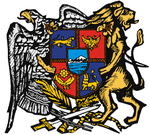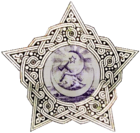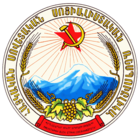
Coat of arms of Armenia
Encyclopedia
The national coat of arms of Armenia
(Armenian
:Հայաստանի Զինանշան, Hayastani Zinanshan) consists of an eagle
and a lion
supporting a shield. The coat of arms combines new and old symbols. The eagle and lion are ancient Armenian symbols dating from the first Armenian kingdoms that existed prior to Christ
.
The current coat of arms was adopted on April 19, 1992, by the Armenian Supreme Council decision. On June 15, 2006, the law on the state coat of arms of Armenia was passed by the Armenian Parliament.
with Noah's Ark
sitting atop it. According to tradition, the ark is said to have finally rested on the mountain after the great flood. Ararat is considered the national symbol of Armenia and thus is of principal importance to the coat of arms. Surrounding Mount Ararat are symbols of old Armenian dynasties. In the lower left portion of the shield, there are two eagles looking at each other, symbolizing the length of the Armenian territory during the reign of the Artaxiad Dynasty
that ruled in the 1st century BC. In the upper left portion, there is a lion with a cross, the emblem for the Bagratuni dynasty that ruled during the Middle Ages
, between the 7th and 11th centuries. Under this dynasty, Armenia blossomed culturally, making its capital, Ani, one of the most important cultural, social and commercial centers of its time. Bagratuni was destroyed by the Byzantine Empire's encroachment and by Seljuk conquests in the 11th century. In the upper right portion, there is a two-headed eagle, the emblem of the first dynasty to reign over a Christian
Armenia, the Arsacid Dynasty of Armenia
. Tiridates III
of Arsacid Dynasty made Armenia the first Christian
nation in 301. This dynasty ruled from the 1st century to 428. In the lower right portion, there is a lion with a cross, the emblem of the Rubenid
dynasty. This dynasty reigned in Armenian Kingdom of Cilicia
, a state that expanded and prospered during the 12th and 13th centuries, until the Mamelukes and Turks
eventually conquered it.
and later on the symbol of the Arsacid Dynasty of Armenia
. It holds the Artaxiad Dynasty's branch of the shield. Whereas, the lion was the symbol of the Bagratuni Dynasty and later on the symbol of the Rubenid
Dynasty. It holds the Rubenid Dynasty's branch of the shield.
Both of these animals were chosen because of their power, courage, patience, wisdom, and nobility in animal kingdom.



(DRA) in 1918. In that year, an early variation of the coat of arms was adopted by the DRA. The symbols on this earlier version were placed in a slightly different order and the eagle and lion have their tongues out, giving them a more menacing look. It is also worthy to note that only Mount Ararat (along with Little Ararat
) are depicted while Noah's Ark is absent. The coat of arms was designed by architect and member of the Russian Academy of Fine Arts Alexander Tamanian
(best known for his work on Yerevan
's city plan) and artist Hakob Kojoyan
.
, Azeri and Georgians
, and unusually features Islam
ic art and communist elements side by side. The latticework in the star itself bespeaks the former coat of arms of Georgia
from 1918–1921 and adopted again from 1991–2004; the crescent moon represents the Muslim Azeris, on a background depicting the national symbol of the Armenians, Mount Ararat.
and red star
behind it. The inclusion of Ararat brought objections from Turkey
because the mountain is part of its territory. The Kremlin
retorted that although the Turkish symbol was the crescent, surely it did not mean that they laid claim to the moon. The Soviet Union broke apart in 1991 and Armenia thus became an independent republic. In 1992, a slightly modified version of the DRA's coat of arms was adopted and has remained in place ever since.
Armenia
Armenia , officially the Republic of Armenia , is a landlocked mountainous country in the Caucasus region of Eurasia...
(Armenian
Armenian language
The Armenian language is an Indo-European language spoken by the Armenian people. It is the official language of the Republic of Armenia as well as in the region of Nagorno-Karabakh. The language is also widely spoken by Armenian communities in the Armenian diaspora...
:Հայաստանի Զինանշան, Hayastani Zinanshan) consists of an eagle
Eagle (heraldry)
The eagle is used in heraldry as a charge, as a supporter, and as a crest. Parts of the eagle's body such as its head, wings or leg are also used as a charge or crest....
and a lion
Lion (heraldry)
The lion is a common charge in heraldry. It traditionally symbolises bravery, valour, strength, and royalty, since traditionally, it is regarded as the king of beasts.-Attitudes:...
supporting a shield. The coat of arms combines new and old symbols. The eagle and lion are ancient Armenian symbols dating from the first Armenian kingdoms that existed prior to Christ
Christ
Christ is the English term for the Greek meaning "the anointed one". It is a translation of the Hebrew , usually transliterated into English as Messiah or Mashiach...
.
The current coat of arms was adopted on April 19, 1992, by the Armenian Supreme Council decision. On June 15, 2006, the law on the state coat of arms of Armenia was passed by the Armenian Parliament.
Shield
The shield itself consists of many components. In the center is a depiction of Mount AraratMount Ararat
Mount Ararat is a snow-capped, dormant volcanic cone in Turkey. It has two peaks: Greater Ararat and Lesser Ararat .The Ararat massif is about in diameter...
with Noah's Ark
Noah's Ark
Noah's Ark is a vessel appearing in the Book of Genesis and the Quran . These narratives describe the construction of the ark by Noah at God's command to save himself, his family, and the world's animals from the worldwide deluge of the Great Flood.In the narrative of the ark, God sees the...
sitting atop it. According to tradition, the ark is said to have finally rested on the mountain after the great flood. Ararat is considered the national symbol of Armenia and thus is of principal importance to the coat of arms. Surrounding Mount Ararat are symbols of old Armenian dynasties. In the lower left portion of the shield, there are two eagles looking at each other, symbolizing the length of the Armenian territory during the reign of the Artaxiad Dynasty
Artaxiad Dynasty
The Artaxiad Dynasty or Ardaxiad Dynasty ruled the Kingdom of Armenia from 189 BC until their overthrow by the Romans in AD 12. Their realm included Greater Armenia, Sophene and intermittently Lesser Armenia and parts of Mesopotamia...
that ruled in the 1st century BC. In the upper left portion, there is a lion with a cross, the emblem for the Bagratuni dynasty that ruled during the Middle Ages
Middle Ages
The Middle Ages is a periodization of European history from the 5th century to the 15th century. The Middle Ages follows the fall of the Western Roman Empire in 476 and precedes the Early Modern Era. It is the middle period of a three-period division of Western history: Classic, Medieval and Modern...
, between the 7th and 11th centuries. Under this dynasty, Armenia blossomed culturally, making its capital, Ani, one of the most important cultural, social and commercial centers of its time. Bagratuni was destroyed by the Byzantine Empire's encroachment and by Seljuk conquests in the 11th century. In the upper right portion, there is a two-headed eagle, the emblem of the first dynasty to reign over a Christian
Christian
A Christian is a person who adheres to Christianity, an Abrahamic, monotheistic religion based on the life and teachings of Jesus of Nazareth as recorded in the Canonical gospels and the letters of the New Testament...
Armenia, the Arsacid Dynasty of Armenia
Arsacid Dynasty of Armenia
The Arsacid dynasty or Arshakuni dynasty ruled the Kingdom of Armenia from 54 AD to 428 AD. Formerly a branch of the Iranian Parthian Arsacids, they became a distinctly Armenian dynasty. Arsacid Kings reigned intermittently throughout the chaotic years following the fall of the Artaxiad Dynasty...
. Tiridates III
Tiridates III of Armenia
Tiridates III or Diritades III was the king of Arsacid Armenia , and is also known as Tiridates the Great ; some scholars incorrectly refer to him as Tiridates IV as a result of the fact that Tiridates I of Armenia reigned twice)...
of Arsacid Dynasty made Armenia the first Christian
Christian
A Christian is a person who adheres to Christianity, an Abrahamic, monotheistic religion based on the life and teachings of Jesus of Nazareth as recorded in the Canonical gospels and the letters of the New Testament...
nation in 301. This dynasty ruled from the 1st century to 428. In the lower right portion, there is a lion with a cross, the emblem of the Rubenid
Rubenid
The Rubenids or Roupenids were an Armenian dynasty who dominated parts of Cilicia, and who established the Armenian Kingdom of Cilicia. The dynasty takes its name from its ancestor, the Armenian prince Ruben I...
dynasty. This dynasty reigned in Armenian Kingdom of Cilicia
Armenian Kingdom of Cilicia
The Armenian Kingdom of Cilicia , also known as the Cilician Armenia, Kingdom of Cilician Armenia or New Armenia, was an independent principality formed during the High Middle Ages by Armenian refugees fleeing the Seljuk invasion of Armenia...
, a state that expanded and prospered during the 12th and 13th centuries, until the Mamelukes and Turks
Ottoman Empire
The Ottoman EmpireIt was usually referred to as the "Ottoman Empire", the "Turkish Empire", the "Ottoman Caliphate" or more commonly "Turkey" by its contemporaries...
eventually conquered it.
Eagle and Lion
The eagle supports the shield on the left side of the coat of arms, while the lion on the right side. The eagle was the symbol of the Artaxiad DynastyArtaxiad Dynasty
The Artaxiad Dynasty or Ardaxiad Dynasty ruled the Kingdom of Armenia from 189 BC until their overthrow by the Romans in AD 12. Their realm included Greater Armenia, Sophene and intermittently Lesser Armenia and parts of Mesopotamia...
and later on the symbol of the Arsacid Dynasty of Armenia
Arsacid Dynasty of Armenia
The Arsacid dynasty or Arshakuni dynasty ruled the Kingdom of Armenia from 54 AD to 428 AD. Formerly a branch of the Iranian Parthian Arsacids, they became a distinctly Armenian dynasty. Arsacid Kings reigned intermittently throughout the chaotic years following the fall of the Artaxiad Dynasty...
. It holds the Artaxiad Dynasty's branch of the shield. Whereas, the lion was the symbol of the Bagratuni Dynasty and later on the symbol of the Rubenid
Rubenid
The Rubenids or Roupenids were an Armenian dynasty who dominated parts of Cilicia, and who established the Armenian Kingdom of Cilicia. The dynasty takes its name from its ancestor, the Armenian prince Ruben I...
Dynasty. It holds the Rubenid Dynasty's branch of the shield.
Both of these animals were chosen because of their power, courage, patience, wisdom, and nobility in animal kingdom.
Five vital elements
- The sword represents the power and strength of the nation, breaking the chains of oppression.
- The broken chain represents effort shown by the nation to gain freedom and independence.
- The wheat ears represent the hard working nature of the Armenian people.
- The feather represents the intellectual and cultural heritage of the Armenian people.
- The ribbon represents the colors of the flag of ArmeniaFlag of ArmeniaThe national flag of Armenia, the Armenian Tricolour , consists of three horizontal bands of equal width, red on the top, blue in the middle, and orange on the bottom. The Armenian Supreme Soviet adopted the current flag on 24 August 1990...
.
History



Coat of arms of the Democratic Republic of Armenia
The present-day Armenian coat of arms has its origins with the establishment of the Democratic Republic of ArmeniaDemocratic Republic of Armenia
The Democratic Republic of Armenia was the first modern establishment of an Armenian state...
(DRA) in 1918. In that year, an early variation of the coat of arms was adopted by the DRA. The symbols on this earlier version were placed in a slightly different order and the eagle and lion have their tongues out, giving them a more menacing look. It is also worthy to note that only Mount Ararat (along with Little Ararat
Little Ararat
Little Ararat, also known as Mount Sis or Lesser Ararat , is the sixth tallest peak in Turkey. It is a large satellite cone located on the eastern flank of the massive Mount Ararat, less than five miles west of Turkey's border with Iran...
) are depicted while Noah's Ark is absent. The coat of arms was designed by architect and member of the Russian Academy of Fine Arts Alexander Tamanian
Alexander Tamanian
Alexander Tamanian was a Russian-born Armenian neoclassical architect, who is remembered today for his work in the city of Yerevan.Born in the city of Yekaterinodar in 1878 in the family of a banker. He graduated from the St Petersburg Academy of Arts in 1904. His works portrayed sensitive and...
(best known for his work on Yerevan
Yerevan
Yerevan is the capital and largest city of Armenia and one of the world's oldest continuously-inhabited cities. Situated along the Hrazdan River, Yerevan is the administrative, cultural, and industrial center of the country...
's city plan) and artist Hakob Kojoyan
Hakob Kojoyan
Hakob Kojoyan was an Armenian artist. He mostly worked in the genres of painting and applied art. Hakob Kojoyan assisted Armenian architect Alexander Tamanian in creating the coat of arms for the Democratic Republic of Armenia.- References :...
.
Transcaucasian SFSR
In 1922, Armenia was incorporated into Transcaucasian SFSR with Georgia and Azerbaijan. The coat of arms of the Transcaucasian SFSR was adopted by the government of the Transcaucasian SFSR. It is uncertain when exactly it was adopted. It incorporates designs from each of the three major groups that combined in the Transcaucasian SFSR, the ArmeniansArmenians
Armenian people or Armenians are a nation and ethnic group native to the Armenian Highland.The largest concentration is in Armenia having a nearly-homogeneous population with 97.9% or 3,145,354 being ethnic Armenian....
, Azeri and Georgians
Georgian people
The Georgians are an ethnic group that have originated in Georgia, where they constitute a majority of the population. Large Georgian communities are also present throughout Russia, European Union, United States, and South America....
, and unusually features Islam
Islam
Islam . The most common are and . : Arabic pronunciation varies regionally. The first vowel ranges from ~~. The second vowel ranges from ~~~...
ic art and communist elements side by side. The latticework in the star itself bespeaks the former coat of arms of Georgia
Coat of arms of Georgia (country)
The coat of arms of the Republic of Georgia was adopted on 1 October 2004. It is partially based on the medieval arms of the Georgian royal house of Bagrationi....
from 1918–1921 and adopted again from 1991–2004; the crescent moon represents the Muslim Azeris, on a background depicting the national symbol of the Armenians, Mount Ararat.
Soviet coat of arms
In 1937, a new coat of arms was adopted. Like the DRA coat of arms, this coat prominently featured Mount Ararat along with the Soviet hammer and sickleHammer and sickle
The hammer and sickle is a part of communist symbolism and its usage indicates an association with Communism, a Communist party, or a Communist state. It features a hammer and a sickle overlapping each other. The two tools are symbols of the industrial proletariat and the peasantry; placing them...
and red star
Red star
A red star, five-pointed and filled, is an important ideological and religious symbol which has been used for various purposes, such as: state emblems, flags, monuments, ornaments, and logos.- Symbol of communism :...
behind it. The inclusion of Ararat brought objections from Turkey
Turkey
Turkey , known officially as the Republic of Turkey , is a Eurasian country located in Western Asia and in East Thrace in Southeastern Europe...
because the mountain is part of its territory. The Kremlin
Moscow Kremlin
The Moscow Kremlin , sometimes referred to as simply The Kremlin, is a historic fortified complex at the heart of Moscow, overlooking the Moskva River , Saint Basil's Cathedral and Red Square and the Alexander Garden...
retorted that although the Turkish symbol was the crescent, surely it did not mean that they laid claim to the moon. The Soviet Union broke apart in 1991 and Armenia thus became an independent republic. In 1992, a slightly modified version of the DRA's coat of arms was adopted and has remained in place ever since.
External links
- Coat of arms of Armenia at Flags of the WorldFlags of the WorldFlags of the World is an Internet-based vexillological association and resource. Its principal project is the Internet's largest website devoted to vexillology, containing comprehensive information about all kinds of flags, and an associated mailing list...
- The Evolution of the Armenian Flag and Coat of Arms
- Armenica.org - Symbolic values and information about the Armenian flag and coat of arms
- National Coat of Arms of the Republic of Armenia - Official website
- Atlas of Conflicts: Examples of Old Armenian Heraldry

